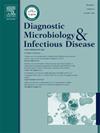Antibiotics prescribing patterns before vs after minimum inhibitory concentration suppression: A quasi-experimental study
IF 2.1
4区 医学
Q3 INFECTIOUS DISEASES
Diagnostic microbiology and infectious disease
Pub Date : 2025-01-15
DOI:10.1016/j.diagmicrobio.2025.116689
引用次数: 0
Abstract
Background
Culture and susceptibility results are essential to optimize antibiotic treatment. Prescribers rely on minimum inhibitory concentration (MIC) interpretation to prescribe antibiotics. Many hospitals include MIC values with the interpretation in culture and susceptibility reports, where comparing MICs can be misleading (i.e., lower MIC doesn't necessarily suggest a more potent antibiotic). It is assumed that suppressing MIC values while keeping the interpretation may enhance the appropriate antibiotic choice. However, no study has evaluated the impact of such intervention. Therefore, we aimed to assess the impact of MIC suppression on appropriateness of antibiotic prescribing.
Methods
This was a quasi-experimental study over 12 months on patients with symptomatic infections confirmed by cultures and who were prescribed definitive antibiotics pre and post MIC suppression in culture reports. Endpoints included appropriateness of antibiotic and several clinical and economic outcomes.
Results
A total of 64 and 56 patients were included in the pre- and post-phase with median age of 57.5 vs. 62.3, respectively (P = 0.406). The appropriateness of antibiotic prescribing was higher in the post-phase (60.7 %), compared to the pre-phase (42.2 %) (P = 0.043). Hospital length of stay was lower in the post-phase compared to the pre-phase (7 vs. 10 days; P = 0.009). Consequently, the hospital stay cost was significantly lower in the post-phase than in the pre-phase ($3733 vs. $5333 P = 0.009).
Conclusion
Our study showed that suppressing MIC values in culture reports was associated with more appropriate antibiotic prescribing, as well as better clinical and economic outcomes. Microbiology labs should consider suppressing MICs as an antimicrobial stewardship intervention.

求助全文
约1分钟内获得全文
求助全文
来源期刊
CiteScore
5.30
自引率
3.40%
发文量
149
审稿时长
56 days
期刊介绍:
Diagnostic Microbiology and Infectious Disease keeps you informed of the latest developments in clinical microbiology and the diagnosis and treatment of infectious diseases. Packed with rigorously peer-reviewed articles and studies in bacteriology, immunology, immunoserology, infectious diseases, mycology, parasitology, and virology, the journal examines new procedures, unusual cases, controversial issues, and important new literature. Diagnostic Microbiology and Infectious Disease distinguished independent editorial board, consisting of experts from many medical specialties, ensures you extensive and authoritative coverage.

 求助内容:
求助内容: 应助结果提醒方式:
应助结果提醒方式:


